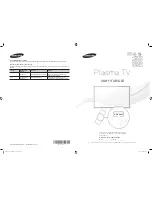
Circuit Operation Description
5-34
Samsung Electronics
(1) First, perform eye-inspection and short circuit inspection for the power stage of the logic board to exam-
ine. Then, perform the following examinations on the board in order if no problem was found.
(2) Replace IC2017(256K EEPROM) of the logic board with Test EERPOM. Change the clock setting of the
logic board to internal referring to the configuration procedures described below.
❈
If there is no available Test EEPROM, you can use PG 00 for Windows NT systems, or PG 40 for
NT/PAL compatible systems by setting address 20 to 81, 22 to 00, 23 to 00,and 70 to 01.
(3) Connect power(5V) to LD1, and check that LED(LD2000) on the left top of the board blinks at about 1
second interval.
(4) If the logic board is out of order, the LED would blink too fast or not be lighted on.
(5) If no problem was found in the above examination, connect sub-PCB for logic output examination, mea-
sure output waveform, and compare the waveform with the appended waveform of normal state.
Record either OK or NG after examination.
(6) Check drive Y s/w, drive X s/w and address signal in order.
(7) Set probe 1 of oscilloscope to trigger signal, and connect it to the TP31 of the logic board.
(8) Set oscilloscope to 2ms/div. After adjusting probe 2 to 5V/div, check output signal.
(9) After T/S, turn off the power supply, and disconnect connector.
(10) Record the result on the examination sheet (either OK or NG).
❐
Jumper settings to select internal or external clock
On the top of the logic main board, there is option jumper (CN01) that allows selecting internal/external
clock. While T/S, set it to internal clock as the following figure shows.
❈
It is set to external clock in normal. Set it to internal clock while examination, and set it to external
clock again after examination.
Figure 1. Jumper Settings to Select Internal / External Clock Signal
Summary of Contents for PS42P2SBX/XEC
Page 2: ...ELECTRONICS Samsung Electronics Co Ltd Nov 2002 Printed in Korea AA82 00157A...
Page 19: ...Circuit Operation Description Samsung Electronics 5 3 5 1 2 D PDP PS 42 BLOCK DIAGRAM...
Page 32: ...Circuit Operation Description 5 16 Samsung Electronics 5 2 3 D DRIVER CIRCUIT DIAGRAM...
Page 33: ...Circuit Operation Description Samsung Electronics 5 17 5 2 3 E DRIVER BOARD CONNECTOR LAYOUT...
Page 34: ...Circuit Operation Description 5 18 Samsung Electronics...
Page 35: ...Circuit Operation Description Samsung Electronics 5 19...
Page 36: ...Circuit Operation Description 5 20 Samsung Electronics...
Page 37: ...Circuit Operation Description Samsung Electronics 5 21...
Page 38: ...Circuit Operation Description 5 22 Samsung Electronics...
Page 39: ...Circuit Operation Description Samsung Electronics 5 23...
Page 40: ...Circuit Operation Description 5 24 Samsung Electronics...
Page 41: ...Circuit Operation Description Samsung Electronics 5 25...
Page 42: ...Circuit Operation Description 5 26 Samsung Electronics...
Page 43: ...Circuit Operation Description Samsung Electronics 5 27...
Page 44: ...Circuit Operation Description 5 28 Samsung Electronics...
Page 45: ...Circuit Operation Description Samsung Electronics 5 29...
Page 46: ...Circuit Operation Description 5 30 Samsung Electronics...
Page 63: ...Circuit Operation Description Samsung Electronics 5 47 Figure 5 42 Single logic buffer...
Page 70: ...Circuit Operation Description 5 54 Samsung Electronics...
Page 71: ...Circuit Operation Description Samsung Electronics 5 55...
Page 72: ...5 56 Samsung Electronics MEMO...
Page 73: ...Circuit Operation Description Samsung Electronics 5 57...
Page 148: ...10 14 Samsung Electronics MEMO...
Page 158: ...9 10 Samsung Electronics MEMO...
Page 164: ...3 2 Samsung Electronics MENO...
Page 170: ...Schematic Diagrams 12 4 Samsung Electronics 12 4 Y Pb Pr Buffer Switching...
Page 173: ...Samsung Electronics Schematic Diagrams 12 7 12 7 Analog to Digital Converter...
Page 174: ...Schematic Diagrams 12 8 Samsung Electronics 12 8 DVI Input Block...
Page 180: ...Schematic Diagrams 12 14 Samsung Electronics 12 15 Sound AMP Module...
















































